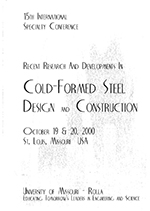Session Dates
19 Oct 2000
Abstract
There is a difference in the shear design criteria between the Canadian cold formed steel design Standard, CSA S136-94 (from here on referred to as S136) and the American Iron and Steel Institute Specification for the design of cold formed steel structures, AISI-96 (from here on referred to as AISI). The focus of this paper was to carry out the appropriate calibrations for the factor of safety, Ω, and the resistance factor, ϕ, using the current design approaches of both countries. In the case of the S136 Standard, only the resistance factor was determined. It was assumed at the outset that the nominal shear expressions should not produce an inconsistency on the shear curve. Using 34 test values from the literature, calibrations were carried out using combinations of S136 and AISI reliability indices, calibration coefficients and shear equations. It was found that using a reliability index of 2.5 and the entire sample size, the existing resistance factor of 0.9 was acceptable in the AISI Specification. This conflicts with the current use of a resistance factor of 1.0 for shear yielding in the AISI Specification. Since Sl36 uses a reliability index of 3.0, the current resistance factor of 0.9 is unconservative. Examining resistance factors for individual failure modes showed areas where the documents are unconservative. Additional calibrations were performed on a proposed consistent set of shear equations. Using a reliability index, β, of 2.5 and the dead and live load factors specified by AISI , a resistance factor of 0.95 and a corresponding factor of safety of 1.62 was determined. With a reliability index, β, of 3.0 and the dead and live load factors specified by S136, a resistance factor of 0.85 was established. It is recommended that the proposed shear expressions be used in the current design documents since they provide a smooth transition between failure modes, as well as a more reliable resistance factor and corresponding factor of safety.
Department(s)
Civil, Architectural and Environmental Engineering
Research Center/Lab(s)
Wei-Wen Yu Center for Cold-Formed Steel Structures
Meeting Name
15th International Specialty Conference on Cold-Formed Steel Structures
Publisher
University of Missouri--Rolla
Document Version
Final Version
Rights
© 2000 University of Missouri--Rolla, All rights reserved.
Document Type
Article - Conference proceedings
File Type
text
Language
English
Recommended Citation
Craig, B. and Schuster, R. M., "Calibration of Cold Formed Steel Shear Equations" (2000). CCFSS Proceedings of International Specialty Conference on Cold-Formed Steel Structures (1971 - 2018). 2.
https://scholarsmine.mst.edu/isccss/15iccfss/15iccfss-session3/2
Calibration of Cold Formed Steel Shear Equations
There is a difference in the shear design criteria between the Canadian cold formed steel design Standard, CSA S136-94 (from here on referred to as S136) and the American Iron and Steel Institute Specification for the design of cold formed steel structures, AISI-96 (from here on referred to as AISI). The focus of this paper was to carry out the appropriate calibrations for the factor of safety, Ω, and the resistance factor, ϕ, using the current design approaches of both countries. In the case of the S136 Standard, only the resistance factor was determined. It was assumed at the outset that the nominal shear expressions should not produce an inconsistency on the shear curve. Using 34 test values from the literature, calibrations were carried out using combinations of S136 and AISI reliability indices, calibration coefficients and shear equations. It was found that using a reliability index of 2.5 and the entire sample size, the existing resistance factor of 0.9 was acceptable in the AISI Specification. This conflicts with the current use of a resistance factor of 1.0 for shear yielding in the AISI Specification. Since Sl36 uses a reliability index of 3.0, the current resistance factor of 0.9 is unconservative. Examining resistance factors for individual failure modes showed areas where the documents are unconservative. Additional calibrations were performed on a proposed consistent set of shear equations. Using a reliability index, β, of 2.5 and the dead and live load factors specified by AISI , a resistance factor of 0.95 and a corresponding factor of safety of 1.62 was determined. With a reliability index, β, of 3.0 and the dead and live load factors specified by S136, a resistance factor of 0.85 was established. It is recommended that the proposed shear expressions be used in the current design documents since they provide a smooth transition between failure modes, as well as a more reliable resistance factor and corresponding factor of safety.



